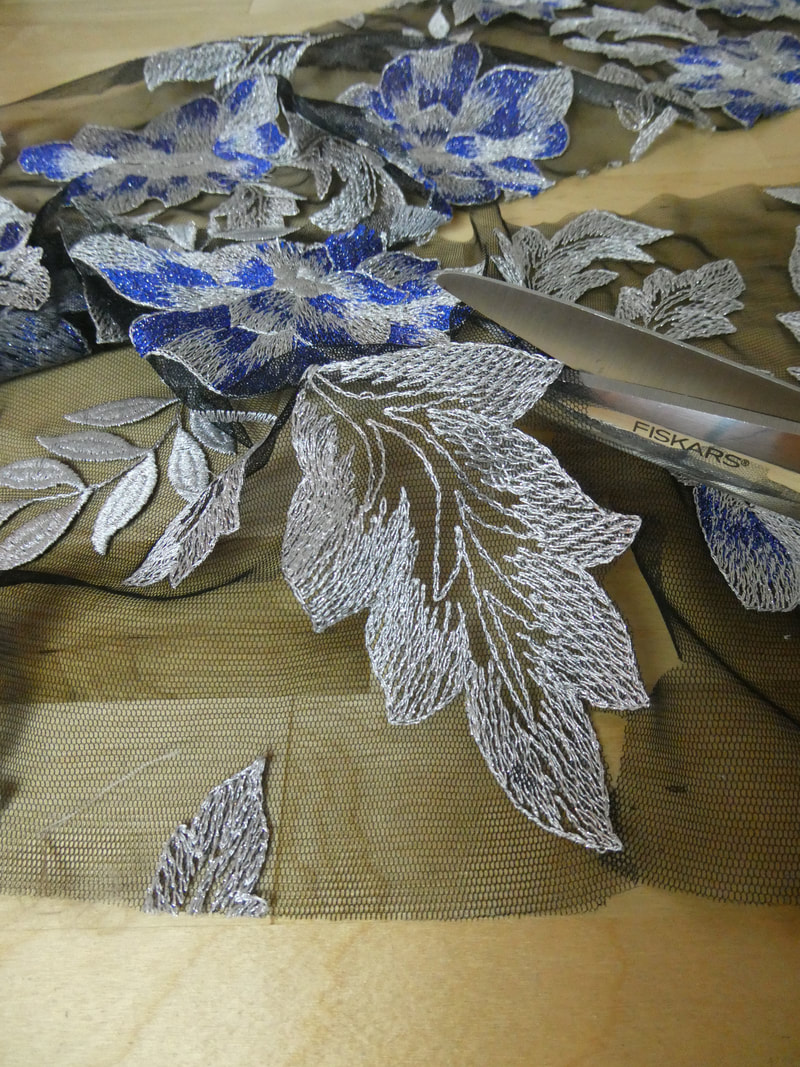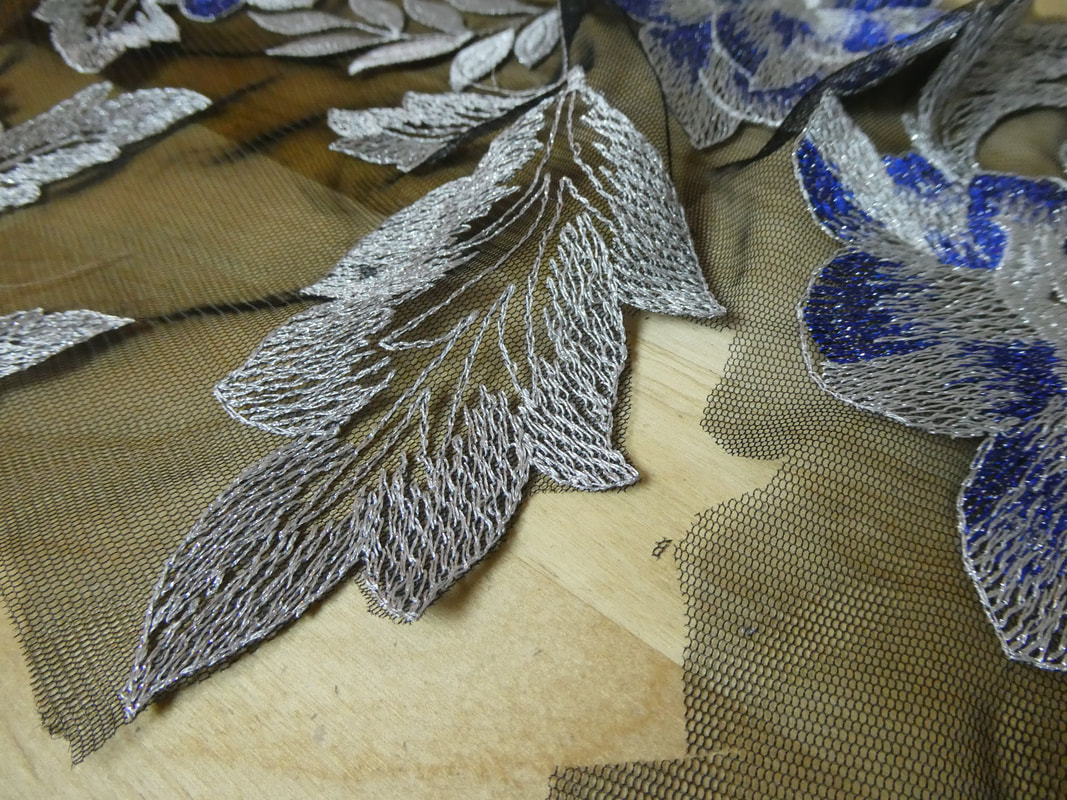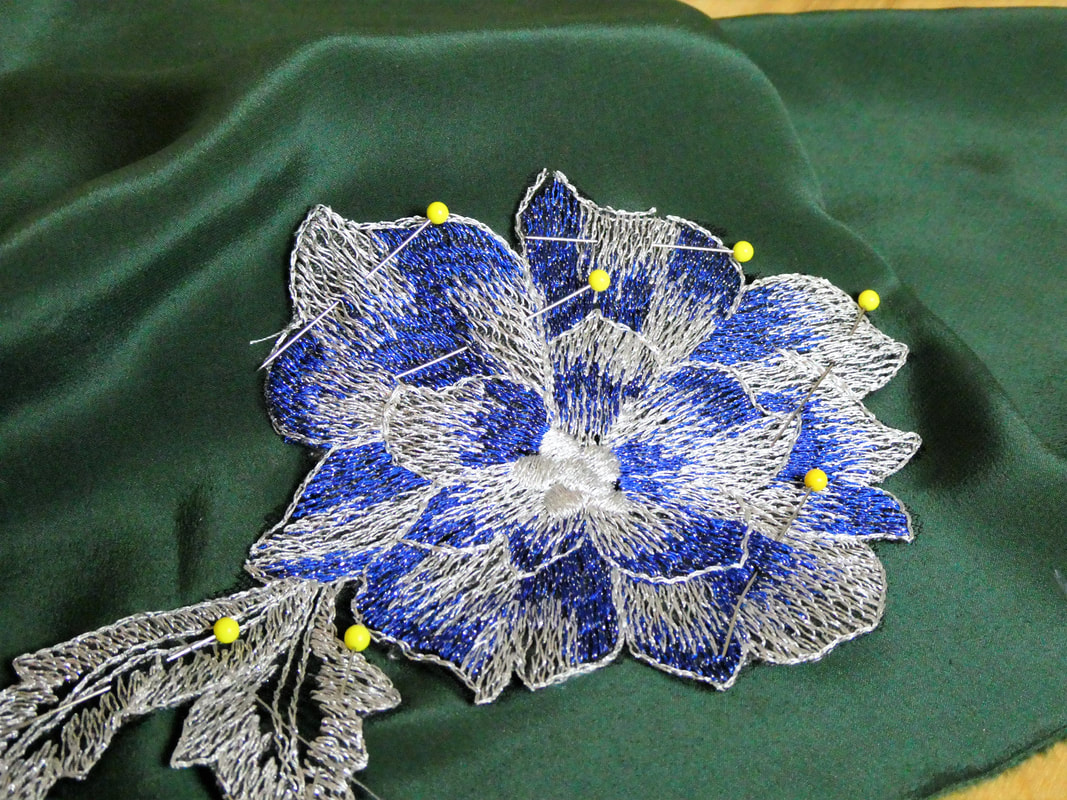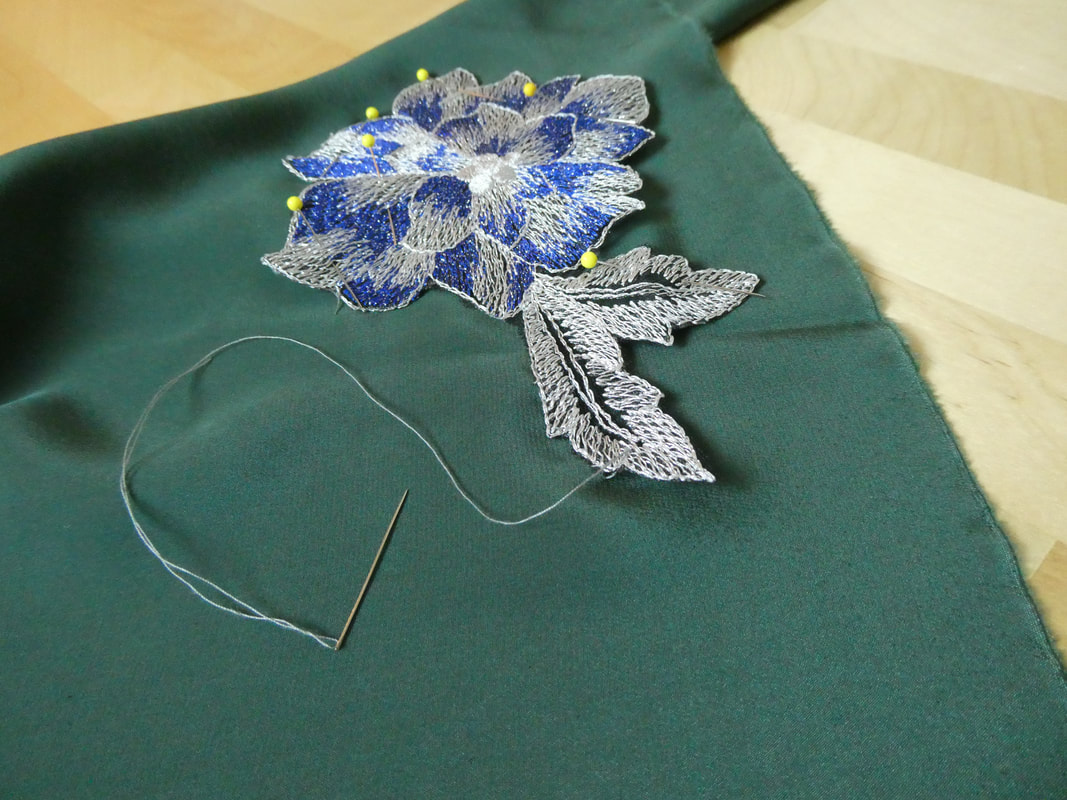|
There are many instances in dressmaking when you’ll be forced to replace that convenient machine sewing needle with a much slower hand sewing one. In the case of sewing decorative appliques, you may be asking yourself- why would I ever need to attach them by hand when I can easily topstitch them on the sewing machine? When it comes to decorative garment applications, things are not always as simple as they appear. In many instances, the only way to safely sew an applique is by hand using a sort of modified slip stitch method. In some scenarios, you may even save some time by opting for hand stitching in lieu of machine stitching altogether. Here are some situations when hand sewing appliques is not only recommended but also essential to the structure, finish and look of a garment:
In today’s tutorial, I’ll go a step further by showing you how to actually extract an applique from a lace or ornamental fabric and hand stitch it to the surface of a silk crepe de chine. The need for this comes up quite often when you can’t find the right pre-cut appliques on the market. In that case, it is totally acceptable to cut your own from a suitable fabric. I’ll show you this simple process below. 1. Cut out the desired applique portion from your fabric carefully following its edges. You want to be close to the applique outer lines but not cut so close that you actually weaken the applique weaving. 2. Choose the desired location of the applique on the garment, and pin it in place in the desired position and orientation. 3. At this point, I suggest hand basting it to the garment as doing so will provide a lot more control and stability in the hand stitching process to follow. 4. Lastly, use thread that matches the applique’s edges and hand stitch through the very outer edge of the applique to the fabric surface underneath. I used a sort of slip stitch style but since my applique is heavier than my fabric, I caught about 2-3 mm of the fabric for increased stability. With a conventional slip stitch, you usually only catch 1-2 threads such that the stitches remain invisible on the other side- mine is just one step more durable. Note: If you are sewing an applique to a garment that has already been lined, only hand stitch through the top garment layer avoiding the lining underneath. Your goal is to hide as much of the hand stitch on the inside of the garment as possible. Continue hand stitching until the entire applique is attached as desired. In most cases, you do not need to iron the finished applique. Especially in instances of working with decorative lace appliques or heat-sensitive fabrics, avoid pressing the application altogether. Similar tutorials you may like: How To Sew With Sequin And Beaded Fabrics How To Sew Novelty Trims And Trim Insets 4 Hand Sewing Stitches And Techniques You Should Know As a Sewing Beginner What Is Basting. How And When To Use It In Garment Construction Sewing Pin Basics: Types Of Pins Used In Dressmaking
2 Comments
10/30/2023 05:36:33 am
Beautiful post! Thank you so much for sharing this wonderful post with us.
Reply
Nowhere Girl
7/2/2024 09:19:16 am
"There are many instances in dressmaking when you’ll be forced to replace that convenient machine sewing needle with a much slower hand sewing one. In the case of sewing decorative appliques, you may be asking yourself- why would I ever need to attach them by hand when I can easily topstitch them on the sewing machine?"
Reply
Leave a Reply. |
The Blog:A journey into our design process, sewing tutorials, fashion tips, and all the inspiring people and things we love. Doina AlexeiDesigner by trade and dressmaker at heart. I spend most of my days obsessing over new fabrics and daydreaming new ideas. Sadie
Executive Assistant & Client Relations Manager Archives
November 2019
Categories
All
|
-
Sewing Tutorials
-
Basics
>
- Aligning Pattern Grainlines To Fabric
- Preparing Fabrics For Sewing
- Pinning Sewing Patterns To Fabric
- Placing Sewing Patterns On Fabric For Cutting
- Rotary Cutters or Fabric Scissors?
- Cutting The Sewing Patterns
- What Are Notches And How To Use Them In The Sewing Process
- Transferring Notches From Pattern To Fabric
- Transferring Seamlines to Fabric
- Staystitching
- Backstitching: A Complete Guide
- Hand Basting: A Complete Guide
- Sewing Continuous Bias Binding
- Darts >
-
Sewing Seams
>
- The Basics Of Seams And Seam Allowance
- How To Sew A Straight Seam
- Sewing Curved Seams
- Sewing Corner Seams
- Trimming And Grading Seam Excess
- Notching/Clipping Seam Allowance for Tension Release
- Sewing Topstitched Seams
- Sewing Corded Seams
- Sewing A Slot Seam
- Sewing A Gathered Seam
- Sewing Bias Seams
- Sewing Seams With Ease
- Sewing Seams With Crossing Seamlines
- Sewing Unlike Fabric Seams
- How To Iron Seams: Ironing Tools And Conventions
- Sewing With Knit Fabrics
- Understanding Stitch Length And Tension
- Sewing Unique Fabric Seams
-
Seam Finishes
>
- Seam Finishing Techniques - Overview
- Applying A Pinked Seam Finish
- Applying A Bias Bound Seam Finish
- Serging And Zigzag Seam Finishes
- Sewing A Self-Bound Seam Finish
- Sewing A French Seam Finish
- Sewing A Hong Kong Seam Finish
- Sewing A Mock French Seam Finish
- Sewing A Turned-and-Stitched Seam Finish
- Sewing Overcast Hand-Applied Seam Finishes
- Sewing A Flat Felled Seam
- Sewing A Hairline Seam Finish
-
Hem Finishes
>
- Garment Hem Finishes: Overview
- Sewing A Double Fold Hem Finish
- Sewing A Single Fold Hem Finish
- Sewing Bound Hem Finishes
- Sewing An Exposed Double Layer Bound Hem
- Sewing A Folded-Up Bound Hem with Pre-folded Binding
- Sewing A Hong Kong Hem Finish
- Sewing A Band Hem Finish
- Sewing A Bias Faced Hem Finish
- Sewing A Twill Tape Hem Finish
- Sewing A Rolled Hem Finish
- Sewing A Shaped Hem Facing
- Using Fusible Hem Tape And Webbing
- Finishing A Lace Fabric Hem
- Finishing A Leather Hem
- Sewing Faced Hem Corners
- How To Finish Lining At The Hem
- Finishing Fabric Corners by Mitering >
- Interfacing A Hemline: Lined And Unlined Examples
-
Sewing Pockets
>
- Curved Patch Pocket With Flap
- Unlined Square Patch Pockets
- Lined Patch Pockets: Two Ways
- Extension On-Seam Pockets
- Separate On-Seam Pocket
- Front Hip Pockets
- Bound Double Welt Pocket
- Double Welt Pocket With Flap
- Self-Welt Pocket (Using Single Fabric Layer)
- Slanted Welt Pocket (Hand-Stitched)
- Faced Slash Pockets: Overview >
-
Sewing Zippers
>
- Sewing Zippers: General Information
- Sewing A Centered Zipper
- Sewing A Lapped Zipper
- Sewing An Invisible Zipper
- Sewing A Fly Front Zipper
- Sewing A Closed-End Exposed Zipper (No Seam)
- Sewing An Exposed Separating Zipper
- Sewing Hand Stitched Zipper Applications
- Sewing A Zipper Underlay
- Sewing A Placket-Enclosed Separating Zipper
- Sleeveless Finishes >
-
Neckline Finishes
>
- Sewing A Neck Shaped Facing
- Sewing An All-In-One Neck Facing
- Neck And Garment Opening Combination Facings >
- Sewing A Bias Faced Neckline Finish
- Sewing A Band Neckline Finish
- Bound Neckline Finishes: Overview >
- Sewing A Semi-Stretch Strip Band Neckline
- Ribbed Neck Band And Classic Turtleneck
- Decorative Neckline Finishes >
- Finishing Facing Edges >
-
Extras
>
- A Complete Guide on Interfacing
- Sewing Bound Spaghetti Straps
- Sewing Spaghetti Straps To A Faced Neckline
- Sewing Ruffles: Overview
- Patterning And Sewing A Circle Ruffle
- Sewing A Gathered Heading Ruffle
- Sewing Double Layer Gathered Ruffles
- Sewing A Gathered Ruffle Into A Seam
- Sewing A Gathered Ruffle To A Fabric Edge
- Sewing A Fabric Surface Slit
- Sewing A Slit Seam
- Hand-Applied Straight Stitches
- Hand-Applied Blind Stitches
- Hand-Applied Overedge Stitches
- Hand-Applied Tack Stitches
- Hand-Applied Decorative Stitches
-
Basics
>
- Custom Bridal
- Custom Apparel
- About
- Blog
Services |
Company |
|








 RSS Feed
RSS Feed

